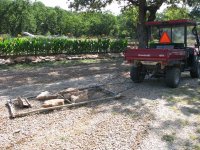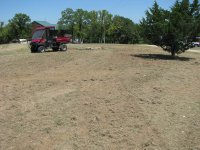jinman
Rest in Peace
- Joined
- Feb 23, 2001
- Messages
- 21,059
- Location
- Texas - Wise County - Sunset
- Tractor
- NHTC45D, NH LB75B, Ford Jubilee
Do you think Bluebonnets would grow in Alabama?
Norris: I do think you can grow bluebonnets in Alabama, but I suspect it will take some real soil modification to have a successful crop. Bluebonnets like extremely high PH basic soils. Those soils are often also nitrogen depleted and that's why the addition of rhizobium bacteria is very helpful. If you can raise the PH of your soil to around 7 and add a little nitrogen fertilizer, you may be able to grow a few bluebonnets. Just don't expect them to spread on their own to surrounding acid soils. They won't do it. You can also improve your germination yield by scarifying the seeds. You can scarify them by roughing them between two pieces of course sandpaper. That will help more of the seeds germinate the first year. The reason I didn't do that, is I'm talking about a lot of seeds and I don't have anything to do the scarification with. I guess if I shelled out the seeds, I could put them in my cement mixer with a bit of sand and crushed rock. I could run the mixer for a couple of hours and that should have the seeds scarified pretty well. I guess the trick would be to find the point where they were scarified, but not pulverized.
Here's a link to the Ladybird Johnson Wildflower Center's expert on plants.
Mr. Smarty Plants
Bird: I think the seeds they sow on the roads have been innoculated and scarified. They are also best on the sides of hills where there is very little topsoil and most likely the PH is high. Haven't you noticed how they seem to grow best on the sides of slopes where they cut the highway through hillsides or put in an overpass? There's no telling how many billions of seeds they plant. Once strarted though, it's easy for them to spread when they mow the ROWs. I always think of bluebonnets growing well in the same environment as grassburrs. Bluebonnets are the spring crop and grassburrs are the summer and fall crop.
Eddie, Ron, two_bit_score, jimmyj and theboman: Thanks for the encouragement and nice words. I hope I don't disappoint you next spring and have lots of bluebonnet pictures.
Robs: We have bluebells here, but they are called Texas Bluebells. They grow along waterlines and around other moist areas along drainage swales. I also have lots of them, but they aren't as showy as the bluebonnets. Here is a link to a bunch of pictures: Texas Bluebells
ronjhall: The bluebonnets are just beyond where you put your motorhome. When I spread the bluebonnet seeds after they dry, I'll spread them to a point just on the border of where you park. If you come next year, you may get to park in the middle of bluebonnets. Either the ground will be blue or I will be.




